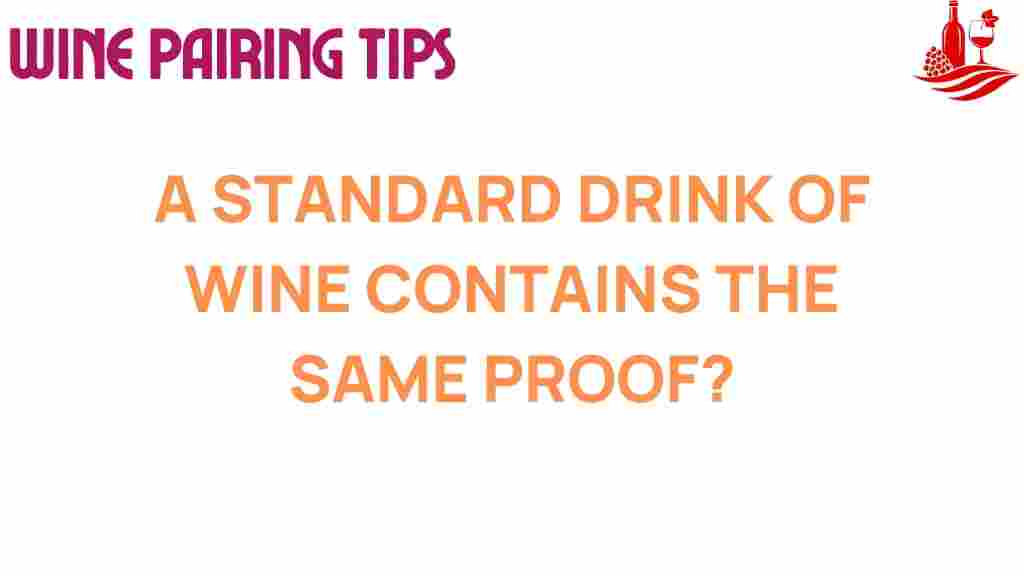Unraveling the Mystery: Does Every Standard Drink of Wine Have the Same Proof?
When it comes to enjoying a glass of wine, many enthusiasts often wonder about the wine proof and how it relates to the standard drink concept. With various wine varieties available, each boasting different alcohol content, it’s essential to understand how these factors interact, especially in the context of beverage regulations. This article aims to demystify the relationship between wine proof and standard drinks, providing insight into the alcohol content in wines and how it varies.
Understanding Wine Proof and Standard Drinks
The term “proof” is often used to express the strength of alcoholic beverages, including wine. In the United States, proof is defined as twice the percentage of alcohol by volume (ABV). For example, if a wine has an ABV of 12%, its proof would be 24. However, not all wines are created equal, and their proofs can vary significantly based on several factors.
A standard drink is a measure used to quantify alcohol consumption. In the U.S., a standard drink contains approximately 14 grams of pure alcohol. This is roughly equivalent to:
- 12 ounces of beer (with about 5% ABV)
- 5 ounces of wine (with about 12% ABV)
- 1.5 ounces of distilled spirits (with about 40% ABV)
With this understanding, let’s explore how different wine varieties affect the concept of standard drinks and wine proof.
Wine Varieties and Their Alcohol Content
Wines come in various styles, each with distinct flavors, aromas, and alcohol concentrations. The alcohol content in wine can vary widely, typically ranging from 5% to 20% ABV. Here are some common wine varieties and their typical ABV levels:
- Table Wines: Generally range from 12% to 15% ABV.
- Fortified Wines: Such as Port or Sherry, usually have an ABV of 16% to 20%.
- Low-Alcohol Wines: Some wines are specifically made with lower alcohol levels, often around 8% to 10% ABV.
- Sparkling Wines: Typically fall between 10% and 12% ABV.
Understanding the alcohol content in these varieties is crucial for determining how many standard drinks one consumes. For instance, a glass of fortified wine could contain more than one standard drink due to its higher alcohol content.
How Beverage Regulations Affect Wine Proof
Beverage regulations play a significant role in how wine proof is defined and displayed. In many countries, including the U.S., the alcohol content must be clearly labeled on the bottle. This regulation ensures that consumers are informed about what they are drinking and can make responsible choices regarding their alcohol consumption.
In the U.S., the Alcohol and Tobacco Tax and Trade Bureau (TTB) regulates the labeling of wine. According to their regulations:
- Wines must display their alcohol content as a percentage of ABV.
- The proof may also be indicated, but it is less common than the ABV.
- Any wine labeled as “low alcohol” must meet specific criteria set by regulatory authorities.
These regulations help consumers understand the strength of their wine, ultimately affecting their consumption and enjoyment.
Calculating Standard Drinks in Wine
To determine how many standard drinks are in a glass of wine, you can use a simple formula based on the wine’s ABV and the volume consumed. Here’s a step-by-step guide:
- Identify the ABV: Check the label on the wine bottle for the alcohol by volume percentage.
- Measure the volume: Determine how much wine you are pouring. A standard serving of wine is typically 5 ounces.
- Use the formula:
Standard Drinks = (ABV × Volume in ounces) / 0.6
For example, if you pour 5 ounces of a wine with 12% ABV, the calculation would be: (12 × 5) / 0.6 = 10 standard drinks.
This calculation can help you gauge your alcohol intake and make informed choices about your consumption.
Troubleshooting Common Questions
Here are some frequently asked questions regarding wine proof and standard drinks:
- Do all wines have the same proof?
No, wine proof varies significantly based on the type of wine and its alcohol content. Always check the label for accurate information.
- How can I find out the alcohol content of a wine?
The alcohol content is typically listed on the wine bottle as a percentage of ABV.
- Is it safe to assume that a glass of wine is always one standard drink?
No, the number of standard drinks in a glass of wine can vary depending on the wine’s ABV and the serving size.
- What should I consider when choosing wine for a gathering?
Consider the alcohol content, the variety of wines available, and the preferences of your guests. It’s also helpful to provide options with different alcohol levels.
Conclusion
In conclusion, understanding wine proof and how it relates to standard drinks is crucial for responsible alcohol consumption. With various wine varieties available, each presenting different alcohol content, it’s important to be aware of the implications of these differences in social situations. Additionally, being informed about beverage regulations ensures you can make educated choices when selecting your favorite wines.
For more information on alcohol consumption and its effects, you can visit the National Institute on Alcohol Abuse and Alcoholism for comprehensive resources.
As you enjoy your next glass of wine, remember to savor the experience while being mindful of your consumption. Cheers!
If you want to learn more about the different types of wines and how to pair them, check out our comprehensive guide on wine varieties.
This article is in the category Tips and created by Wine Pairing Tips Team
